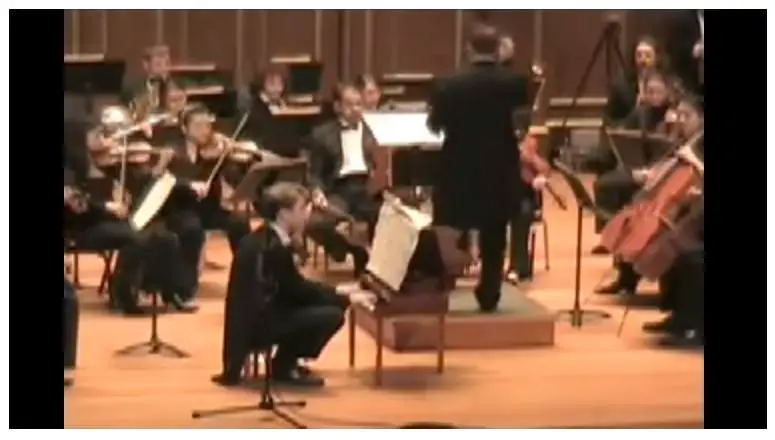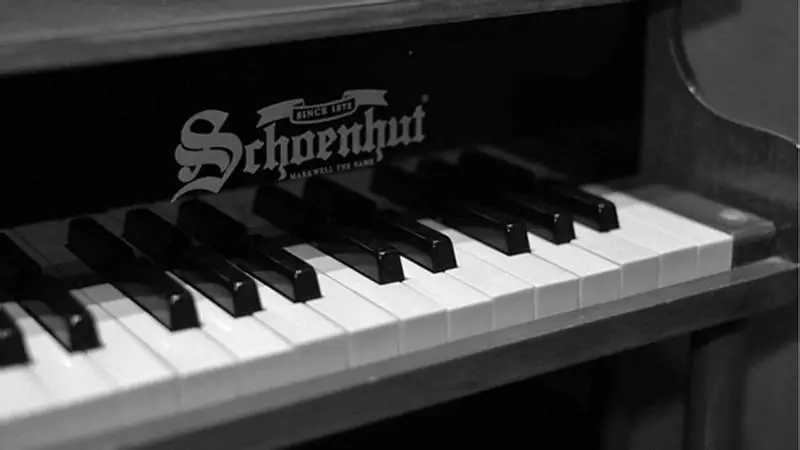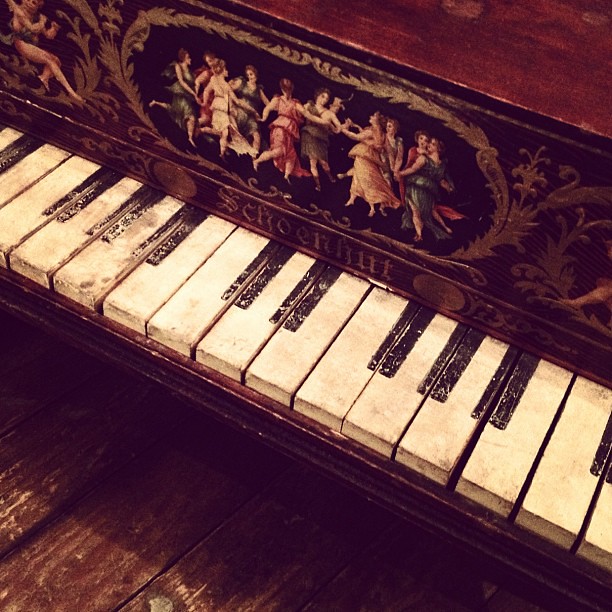
Professional toy pianos for Musicians: Wile the popularity of these instruments is nowhere close to that of its full-size counterpart, several musicians have experimented with the unique tones of toy pianos for their music compositions. These small pianos are inspired by the real pianos or grand pianos, have around one and half octave to three octaves.
Inside a Toy Piano
A toy piano, also known as the kinderklavier (child’s keyboard), is a small piano-like musical instrument that produces chime-like sounds.
The toy piano is typically around a foot wide, spans around one and a half octaves (a full length piano has 7 and a half octaves), yet there are many musicians who consider the toy piano to be an instrument in its own right.
The sound producing mechanism is a bit different in a toy piano and a real piano. On regular pianos, the sound is produced when hammers inside the instrument strike strings, but in a toy piano, the hammers strike metal rods, resulting in a different kind of sound (sounds higher pitched, more percussive, chime like).

Even though the toy piano is seen as an instrument for kids and appreciated for its cuteness, there’s actually more to the instrument. Its capable of displaying a range of emotional expressions, as demonstrated by musicians below, and is used in music across genres.
Toy pianos lack the loudness, timbre, and overall quality of a full size piano, but classically trained musicians and composers are fascinated by the unique sound produced by these instruments. The toy pianos made by top brands, such as Schoenhut, are used by classically trained/professional musicians to perform concerts, and several music composers have used a toy piano in their music compositions before.

Toy Pianos Used by Music Composers
Modern composers, who are always on the lookout for unique instruments, have taken the toy piano seriously enough.
Did you know that in 2001, the Library of Congress accorded music written for toy piano its own subject heading and call number?
There are several composers who have composed pieces specifically for the toy piano, and many have used the unique sound of the toy piano in various music compositions.
Here are some videos that will provide a a sense of what the little piano is capable of, and its importance.
Composer Julian Grant’s Etudes transcendentales pour le toy piano (2013) imagines Liszt at the toy piano:
Watch Face the Music perform composer Tristan Perich’s “Qsqsqsqsqsqsqsqqqqqqqqqqqq,” for three toy pianos and electronics at Ecstatic Music Festival in Merkin Hall. Reminds of video games music?
In the French film Amelie, the Waltz of the Monsters (Yann Tiersen’s album) features extensively. In that piece of music, two toy pianos are played simultaneously to create bouncing rhythms, similar to a harpsichord.
Musicians & Festivals Devoted to the Instrument
There are some musicians who have focused solely on the toy piano. For them, its not just an instrument of their ensemble, the toy piano is their specialty.
Pianist and composer Phyllis Chen has released several albums dedicated to the toy piano (with few accompanying instruments). A toy piano player, Chen says now she forgets about the novelty of the instrument and focuses more on its possibilities.
Watch Phyllis Chen performs her composition “Three Lullabies” with the Boston-based chamber orchestra A Far Cry.
- UnCaged Toy Piano Festival is Chen’s annual festival and composition competition for toy piano music.
Toy Piano in Popular Music
Examples of Toy piano in popular music:
Seals and Croft used the toy piano in their 1972 hit “Summer Breeze”.
Stephin Merritt (Magnetic Fields) Plays Beck, With A Toy Piano
Alt-J uses the toy piano (at about 50 seconds) into the single “Breezeblocks.”
Vampire Weekend, Evanescence, and Sigur Rós are just a few musicians who commonly use the toy piano in their music.
Vintage Toy Piano
Watch: Take a look at this Vintage Child’s Toy Schoenhut Piano
TOY PIANO for MUSICIANS: What to Buy?
If you have spent some time looking around for these musical instruments, you may have definitely come across the brand “Schoenhut”, named after a German immigrant named Albert Schoenhut who invented it way back in 1872. But there are a couple of other good options as well.
Top toy pianos for musicians:
- KAWAI mini piano P-32: 32-Key Toy piano with refined sound (different tone from the Schoenhuts).
- Schoenhut Day Care Toy piano: 37-Key, durable toy piano
- Korg Tiny Piano: This is a digital toy piano with several built-in sounds, but great quality
Schoenhut Toy Piano
Probably the most popular brand, when it comes to toy pianos, is ‘Schoenhut’. If you buy a toy piano today, its most likely that it will be from the Schoenhut Company, founded by Alfred Schoenhut in 1812.
Checkout more Schoenhut toy pianos here.
Kawai TOY PIANO
This piano is more refined so it may not be suitable for kids (not sure if it can handle the wear and tear). However, for older kids who take care of their things, this can be a nice toy piano to get started.In the US, Schoenhut is the only choice for musicians when it comes to toy pianos. But most musicians find the Schoenhut pianos loud and plinky. If you are a musician looking for a quality toy piano to record and perform with, the Kawai toy piano is a nice option that can be used in a professional setting. This piano’s delicate design lets you play music rather than just bash on the keys.
Useful Links
- Schoenhut Toy Pianos: Leading manufacturer of toy pianos.
- Miniature Piano Museum: Photos of Toy Pianos Collection from the Miniature Piano Museum.
- Make your own Electronic Toy Piano Circuit using 555 timer IC chip. In this piano, you can make the timer generate 5-15 different kind of sounds.
Toy Piano Festival, which encourages new works for toy piano and other unusual musical instruments. This initially began as a music composition competition and is now a fully-fledged festival.
KeytarHQ editorial team includes musicians who write and review products for pianists, keyboardists, guitarists & other musicians. KeytarHQ is the best online resource for information on keyboards, pianos, synths, keytars, guitars and music gear for musicians of all abilities, ages and interests.



Classically-trained musician Margaret Leng Tan regulalrly performs concerts on her toy pianos, toy drums, and other instruments (such as cans, dishes). She beleives that “Poor tools require better skills,” and says it has taken her years to master the toy piano, which she plays so beautifully.
Referred to as the “the doyenne of toy pianos” by The New York Times, Margaret was the first woman to graduate with a doctorate in 1971 from the prestigious Juilliard school in New York.
John Cage’s Suite for Toy Piano…This work may also be performed on a traditional piano. It was originally used as music for the choreographed piece by Merce Cunningham, “A Diversion.” This suite is in 5 short, numbered movements, and obviously employs a very limited gamut of tones: the nine white keys from E below middle C to the F above. Those for Movements I and V are limited to five tones: G to D. Only in movements III and IV do all nine tones appear. The rhythmic structure is 7-7-6-6-4. This suite is one of Cage’s most charming and whimsical compositions. It is humorous and somewhat ironic, giving exaggerated dynamics that can’t be fully realized on a toy piano, i.e. from sffz to ppp. In 1963, Lou Harrison made an arrangement of this work for orchestra (3333 4330 timpani, percussion, piano, celesta, harp, strings), which was subsequently published by C.F. Peters (nr.6758a).